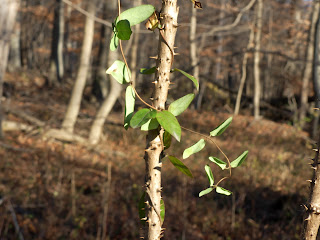Japanese Honeysuckle
Here's another invasive plant species, the Japanese Honeysuckle. And it's engaged in invasive-on-invasive violence, beginning its classic climb-and-strangle strategy on yesterday's invasive plant, the Japanese Angelica Tree. My impression is that all those prickles on the Japanese Angelica Tree won't save it; the Japanese Honeysuckle will presumably maneuver between them as it climbs.
I'm not sure what happens to mature trees when Japanese Honeysuckle moves in. I'm sure they'll climb the trees and that it's foliage will compete with the tree's foliage for sunlight. I know that Japanese Honeysuckle will kill young trees as they wind themselves tightly around the trunk, so I suspect it'll also damage newer tree branches even if thick bark protects the main trunk from the Japanese Honeysuckle.
If there's nothing to climb, Japanese Honeysuckle will form thick clusters that catch almost all the sunlight, making it very difficult for any other plants to even successfully germinate.
Unlike some invasive plants, it sounds like the foliage can be eaten by at least some of our herbivores, though given how much of it I see by the end of winter I suspect it's not the favorite meal for our deer population.
If the plant isn't too mature, you're probably better off pulling it out by the roots, though it sounds like if any rhizome remains the Japanese Honeysuckle may be able to resurrect itself.
 |
| November 22, 2022 at Washington Valley Park Photo 251084658, (c) jpviolette, some rights reserved (CC BY-NC) |



Comments
Post a Comment